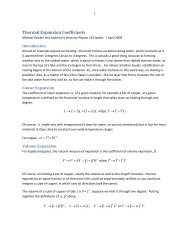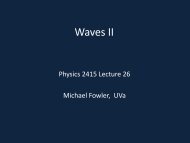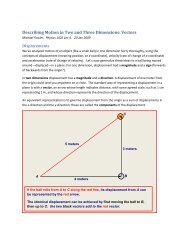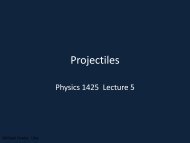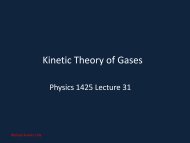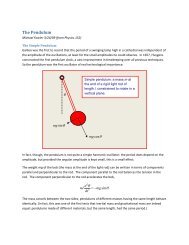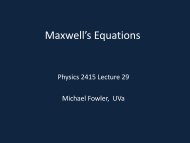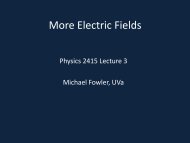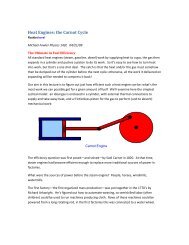21. Angular Momentum - Galileo and Einstein
21. Angular Momentum - Galileo and Einstein
21. Angular Momentum - Galileo and Einstein
Create successful ePaper yourself
Turn your PDF publications into a flip-book with our unique Google optimized e-Paper software.
<strong>Angular</strong> <strong>Momentum</strong>Physics 1425 Lecture 21Michael Fowler, UVa
A New Look for τ = Iα• We’ve seen how τ = Iα works for a bodyrotating about a fixed axis.• τ = Iα is not true in general if the axis ofrotation is itself accelerating• BUT it IS true if the axis is through the CM,<strong>and</strong> isn’t changing direction!• This is quite tricky to prove—it’s in the book• And τ CM = I CM α CM is often useful, as we’ll see.
Forces on Hoop Rolling Down Ramp• Take no slipping, sov = Rω, a = Rα• Translational accn F = ma:mgsinθ - F fr = ma• Rotational accn τ CM = I CM α CM :F fr R = mR 2 α = mRaso F fr = ma <strong>and</strong>mgsinθ = 2ma,• a = (gsinθ )/2:the acceleration is one-halfthat of a sliding frictionlessblock—<strong>and</strong> independent ofmass or radius.• xF frmgsinθThe only force having torqueabout the center of the hoop (itsCM) is the frictional force: thetotal gravitational force <strong>and</strong> thenormal force both act throughthe center.
Yet Another Look at That Hoop…• Take no slipping, sov = Rω, a = Rα• Since there’s no slipping, thepoint on the hoop in contactwith the ramp is momentarilyat rest, <strong>and</strong> the hoop is rotatingabout that point.• The only torque about thatpoint is gravity—τ = mgRsinθ• The moment of inertia aboutthat point, from the parallelaxis theorem, is I CM + mR 2 =2mR 2 , so mgRsinθ = 2mR 2 α,<strong>and</strong> a = α/R = (gsinθ )/2.• xF frmgsinθ
Clicker Question• A wooden yo-yo with redstring rests on a table top.I pull the string horizontallyfrom the bottom. What willthe yo-yo do? (Assumeordinary smooth wood.)• uA. Roll towards me.B. Roll away from me.C. Slide towards me.
Clicker Question• A wooden yo-yo with redstring rests on a table top.I pull the string along a linethat passes through thepoint of contact. What willthe yo-yo do? (Assumeordinary smooth wood.)• uA. Roll towards me.B. Roll away from me.C. Slide towards me.
Varying Moment of Inertia• Recall Newton wrote hisSecond Law F = dp/dt,allowing m to vary aswell as v.• We should write therotational version• τ = d(Iω)/dt, <strong>and</strong> in factvarying I’s are far morecommon than varyingm’s.
Clicker Question• Assume that when she pulls herselfinwards, the angular velocityincreases by a factor of 3.• What happens to 1: total angularmomentum <strong>and</strong> 2: rotational kineticenergy?A. No change, no changeB. No change, x3 increase.C. x3 increase, x3 increaseD. x3 increase, x9 increase
Torque as a Vector• Suppose we have a wheel spinning about a fixedaxis: then ω always points along the axis—sod ω / dt points along the axis too.• If we want to write a vector equation τ = Iα = Idωit’s clear that the vector/ dtτ is parallel to thevector d ω / dt : so points along the axis too!τ • BUT this vector τ , is, remember made of twoother vectors: the force F <strong>and</strong> the place r where it acts!
Recalling an Earlier Torque• Only the component of Fperpendicular to the armexerts torqueτ =rF sinθτ • We can see the direction ofis perpendicular to bothFr , <strong>and</strong> towards us.• We define the vector cross product τ = r× Fto havethis direction, <strong>and</strong> magnitude.rF sinθ• Kids on seesawrθF
More Torque…• Expressing the forcevector F as a sum ofcomponents F ⊥(“fperp”)perpendicular to the leverarm <strong>and</strong> F parallel to the arm, it’s clear that only F ⊥has leverage, that is,torque, about O.F ⊥ has magnitude Fsinθ ,so τ = rFsinθ .• Alternatively, keep F <strong>and</strong>measure its lever armabout O: that’s rsinθ .• xOOrsinθrrθF ⊥θθF F F
Definition: The Vector Cross Product C = A×B• The magnitude C isABsinθ , where θ is theangle between thevectors AB , .• The direction of C isperpendicular to both A <strong>and</strong> B , <strong>and</strong> is your rightthumb direction if yourcurling fingers go fromto .B A • gC θA B
AssumeClicker Question AB ,are nonzero vectors.Which pair of statements below is correct?A. The cross product depends on the order ofthe factors, <strong>and</strong> since both vectors arenonzero, it can never be zero.B. Depends on order , can be zero.C. Doesn’t depend on order, cannot be zero.D. Doesn’tg depend on order, can be zero.
The Vector Cross Product inComponents• Recall we defined theunit vectors iˆ, ˆjk, ˆpointing along the x, y, zaxes respectively, <strong>and</strong> avector can be expressedas A= Aiˆˆ ˆx+ Ay j+Akz• Now• So• giˆ× iˆ= 0, iˆ× ˆj = kˆ, iˆ× kˆ=−ˆj, A× B= Aiˆ+ A ˆj + Akˆ× Biˆ+ B ˆj + Bkˆ( ) ( )x y z x y z= iˆAB − + ( AB )y z z yˆkîĵ




